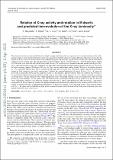Files in this item
Relation of X-ray activity and rotation in M dwarfs and predicted time-evolution of the X-ray luminosity
Item metadata
| dc.contributor.author | Magaudda, E. | |
| dc.contributor.author | Stelzer, B. | |
| dc.contributor.author | Covey, K. R. | |
| dc.contributor.author | Raetz, St. | |
| dc.contributor.author | Matt, S. P. | |
| dc.contributor.author | Scholz, A. | |
| dc.date.accessioned | 2020-10-27T16:56:58Z | |
| dc.date.available | 2020-10-27T16:56:58Z | |
| dc.date.issued | 2020-06 | |
| dc.identifier | 270886001 | |
| dc.identifier | 70afadfc-e30e-4ff4-bc49-cd1e93a08edb | |
| dc.identifier | 85088144332 | |
| dc.identifier | 000540420700007 | |
| dc.identifier.citation | Magaudda , E , Stelzer , B , Covey , K R , Raetz , S , Matt , S P & Scholz , A 2020 , ' Relation of X-ray activity and rotation in M dwarfs and predicted time-evolution of the X-ray luminosity ' , Astronomy & Astrophysics , vol. 638 , A20 . https://doi.org/10.1051/0004-6361/201937408 | en |
| dc.identifier.issn | 0004-6361 | |
| dc.identifier.other | BibCode: 2020A&A...638A..20M | |
| dc.identifier.uri | https://hdl.handle.net/10023/20834 | |
| dc.description | Funding: EM was supported by the Bundesministerium für Wirtschaft und Energie through the Deutsches Zentrum für Luft- und Raumfahrt e.V. (DLR) under grant number FKZ 50 OR 1808. SPM is supported by the European Research Council, under the European Union’s Horizon 2020 research and innovation program (agreement No. 682393, AWESoMeStars). AS’s work is supported by the STFC grant no. ST/R000824/1. | en |
| dc.description.abstract | The relation of activity to rotation in M dwarfs is of high astrophysical interest because it provides observational evidence of the stellar dynamo, which is poorly understood for low-mass stars, especially in the fully convective regime. Previous studies have shown that the relation of X-ray activity to rotation consists of two different regimes: the saturated regime for fast-rotating stars and the unsaturated regime for slowly rotating stars. The transition between the two regimes lies at a rotation period of ∼10 d. We present here a sample of 14 M dwarf stars observed with XMM-Newton and Chandra, for which we also computed rotational periods from Kepler Two-Wheel (K2) Mission light curves. We compiled X-ray and rotation data from the literature and homogenized all data sets to provide the largest uniform sample of M dwarfs (302 stars) for X-ray activity and rotation studies to date. We then fit the relation between Lx − Prot using three different mass bins to separate partially and fully convective stars. We found a steeper slope in the unsaturated regime for fully convective stars and a nonconstant Lx level in the saturated regime for all masses. In the Lx/Lbol − RO space we discovered a remarkable double gap that might be related to a discontinuous period evolution. Then we combined the evolution of Prot predicted by angular momentum evolution models with our new results on the empirical Lx − Prot relation to provide an estimate for the age decay of X-ray luminosity. We compare predictions of this relationship with the actual X-ray luminosities of M stars with known ages from 100 Myr to a few billion years. We find remarkably good agreement between the predicted Lx and the observed values for partially convective stars. However, for fully convective stars at ages of a few billion years, the constructed Lx-age relation overpredicts the X-ray luminosity because the angular momentum evolution model underpredicts the rotation period of these stars. Finally, we examine the effect of different parameterizations for the Rossby number (RO) on the shape of the activity-rotation relation in Lx/Lbol − RO space, and we find that the slope in the unsaturated regime and the location of the break point of the dual power-law depend sensitively on the choice of RO. | |
| dc.format.extent | 14 | |
| dc.format.extent | 1046014 | |
| dc.language.iso | eng | |
| dc.relation.ispartof | Astronomy & Astrophysics | en |
| dc.subject | Stars: low-mass | en |
| dc.subject | Stars: activity | en |
| dc.subject | Stars: rotation | en |
| dc.subject | Stars: magnetic field | en |
| dc.subject | X-rays: stars | en |
| dc.subject | QB Astronomy | en |
| dc.subject | QC Physics | en |
| dc.subject | DAS | en |
| dc.subject.lcc | QB | en |
| dc.subject.lcc | QC | en |
| dc.title | Relation of X-ray activity and rotation in M dwarfs and predicted time-evolution of the X-ray luminosity | en |
| dc.type | Journal article | en |
| dc.contributor.sponsor | Science & Technology Facilities Council | en |
| dc.contributor.institution | University of St Andrews. School of Physics and Astronomy | en |
| dc.contributor.institution | University of St Andrews. St Andrews Centre for Exoplanet Science | en |
| dc.identifier.doi | 10.1051/0004-6361/201937408 | |
| dc.description.status | Peer reviewed | en |
| dc.identifier.url | https://arxiv.org/abs/2004.02904 | en |
| dc.identifier.url | http://adsabs.harvard.edu/abs/2020A%26A...638A..20M | en |
| dc.identifier.grantnumber | ST/R00824/1 | en |
This item appears in the following Collection(s)
Items in the St Andrews Research Repository are protected by copyright, with all rights reserved, unless otherwise indicated.

